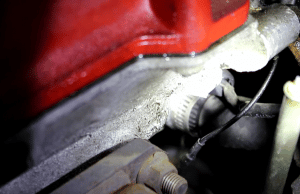If your vehicle leaks any fluid, there must be an issue in your car. The coolant warning light would come on and you can use an Obd2 Scanner with Abs and Srs to get the trouble codes. Leaving a fluid leak unchecked for long periods of time might lead your car to run badly or perhaps cause significant damage. Detecting and determining the source of a coolant leak can save you a lot of time and money. Let’s learn more about the coolant leak causes, symptoms, and solutions below.
If you want to watch the video please see on YOUTUBE.
Common Causes of Leaking Coolant
A coolant leak could be caused by one or more of a number of different things. Even if you don’t notice any signs, regular car maintenance or scanners like Foxwell NT510 Elite & NT530 can catch any of these problems before they become serious.
- Leaky Radiator: Because of its upfront location, the radiator takes a lot of hits and contacts. When a radiator breaks, it leaves a hole in the metal that allows coolant to leak out. If the gasket that connects the reservoir and the radiator has been worn out, a leak may likely occur. Alternatively, one of those radiator hoses may have ruptured over time, causing a leak.
- Unsealing Radiator Cap: This small cap has a big impact on the cooling system, even if you don’t think about it. The cap holds the high pressure coming from the radiator. In order for the system to function properly, the cap provides a solid and trustworthy seal part. The seal on this cap deteriorates over time, causing coolant to leak out of the device.
- Broken Head Gasket: The head gasket in your car is in charge of keeping the coolant and oil separate. There is a chance that the leak isn’t noticeable until it’s too late. However, you may see coolant in the oil or the other way around. Temperatures in the engine will also begin to climb. When coolant leaks outside the engine, it’s a sign that something is seriously wrong.
- Faulty Water Pump: Coolant is circulated through the system via the water pump. Belt-driven water pumps are the most common. The engine crankshaft is connected via this belt, however, it is prone to leaks and corrosive exposure. External damage can also cause a leak in the water pump itself. Either way, a malfunctioning coolant pump will result in an overheated engine since the fluid will be unable to circulate correctly.
- Leaking or Damaged Expansion/Reservoir Tank: Coolant is stored in a plastic container next to the engine. A hose is used to connect it to the radiator. Its principal function is to supply the radiator with coolant as required. In time, the plastic would become brittle. It is prone to breaking and leaking. Hoses connecting it can potentially wear down and leak.
Common Symptoms of Leaking Coolant

You need to know some common symptoms to determine whether or not your car has a coolant leak. Before using an OBD2 Bluetooth Adapter to get the codes, you can inspect the vehicle thoroughly and look for any of these symptoms:
- Noticeable Coolant Pool: If your automobile has a leaky coolant and has been parked in the same spot for a lengthy period of time, you should have it checked. There is a possibility that you will uncover a large pool of coolant under your automobile, depending on the severity. You will almost certainly find a large, clearly visible flood under your car if it hasn’t been moved for some time. Coolants used by the majority of automobile manufacturers are typically brightly colored to make them stand out from the rest of the vehicle’s fluid.
- Overheating Engine: Small leaks might not create a pool underneath. However, this kind of leakage is more worrisome because you won’t be able to detect it. The engine overheats even if you’re just driving for a short distance, which indicates that your automobile is running low on coolant.
- Inadequate Coolant in The Reservoir: Every car has a reservoir tank that contains additional coolant if the engine coolant supply dips. The car refills it from the reservoir. If there’s no coolant in the reservoir tank, the automobile has used it all and must be refilled. If this happens constantly and the expansion tank empties after a few days, coolant may be leaking. It needs to be checked ASAP.
- Coolant Light Coming on: When your car’s coolant level drops too low, the coolant warning light will illuminate, which is another telltale sign that your coolant is running low. In this condition, you can use Innova 3020 to retrieve the codes. The coolant in your automobile needs to be replaced periodically, but if you notice the warning light on regularly, there’s a good probability that you have a leaky coolant issue.
- Radiator Has Bubbles: You shouldn’t see any bubbles in the expansion tanks or the radiator pipes. Combustion gasses exiting the engine may find their way into the expansion tank or the radiator if there is a leak. It’s possible to see bubbles there, which is a clear sign of coolant leaks.
- Rusty or Discolored Radiator: If coolant drips or drops on the radiator while the car is running, it will soon boil and create a stain or discoloration. If you see the radiator’s body becoming rusty or discolored, it’s likely that coolant is leaking from the radiator.
Diagnosis:
How To Stop Coolant from Leaking
Once you’ve thoroughly diagnosed your car’s coolant leak. You should repair it ASAP before clearing the light with an Autel Maxicom Mk808bt scanner. If the leak isn’t too bad, you can fix it yourself. If you can’t fix the problem, calling a professional would be the best solution.
1. Resealing The Leaks
Use a sealer or stop-leak concentrate to fill up and reseal small breaches in your car’s cooling system in the event of coolant leaks. There are a plethora of excellent sealers to choose from at your local hardware store or even online.
2. Replace The Hose
If the leak is coming from the hoses, the simplest technique you may try is to either repair the hoses or replace them with new ones. These would certainly stop the leakage on hoses.
3. Changing the Radiator Cap
In most circumstances, if a radiator cap is leaking coolant, replacing it with a newer one will stop the leak. When the radiator cap fails, the cooling system’s internal pressure will cause the coolant to leak out. A radiator cap isn’t an expensive replacement anyway.
4. Repairing or Replacing The Reservoir Tank
As a side note, if the coolant reservoir tank is leaking, you should have it fixed immediately. Due to the material used, the expansion tank may become fragile over time. As a result, tiny cracks can form and the coolant can seep out of them. As a result, you should be regularly checking your vehicle’s reservoir tank for leaks.
If a sealer doesn’t work to stop the leak from the reservoir tank, your only alternative is to get a new one. Don’t try to do this on your own; you should seek professional guidance.
5. Replacing the Waterpump
A defective or wrecked water pump may be to blame for the low coolant pressure. As it can’t be repaired, it’s best to replace it as soon as possible. This means that the best course of action is to get a new one if coolant is dripping out of it. However, DIY replacement isn’t possible because it’s installed in the cooling system, which you shouldn’t try to dismantle yourself. As a result, we highly recommend you get professional help.
6. Fixing or Replacing the Head Gasket
Attempting to repair a leaking car’s head gasket on your own is fraught with danger, as you could end up ruining other components. That said, if you need to remedy a leak from the head gasket, you should absolutely consult an expert.
7. Testing and Resetting
You can now test your car to discover if the leaking coolant still exists after you’ve repaired it. To enable the cooling system, drive your car for around fifteen minutes and give it a break. If you still notice the symptoms, you can inspect the pieces that were replaced or repaired.
Final Thoughts!
Coolant can leak at different components and due to different reasons. Some issues are fixable while others like hoses or the water pump, are better to get a replacement.
You can only use the scanner to reset the code if you’ve fixed the coolant leak problems properly. In some cases, it’s better to get professional help to either repair or replace coolant-related components.

As a mechanical engineer, it’s easy for David to explain the functionality of the tool. David test most of the tools before writing a review. its help him to learn something new and suggest the best product for you.





